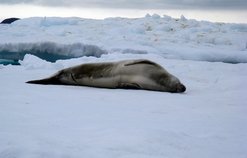

Lobodon carcinophaga (Hombrot & Jacquinot, 1842)
provided by EG-BAMM, Mark Hindell
Description
Crabeater seals have a circumpolar distribution, and are largely restricted to Antarctic pack-ice which makes them difficult to access for scientific study. Adults are 2.0-2.6 m in length, with females slightly larger than males. Weight can vary considerably throughout the year, but are typically in the range of 180-225 kg. Colour is also variable with old, pre-moult coats being silvery white and post-moult coats light to medium brown. The coats are often flecked with darker brown, and tend to be darker on the dorsal surface. They are commonly heavily scarred from encounters with leopard seals, a common predator of young crabeater seals, or from intra-specific interactions as adults during the breeding season. Crabeater seals have highly specialised and distinctive multi-cusped post canine teeth which can interlock to form a sieve when filter feeding on zooplankton.
11459 times added


Species distribution
Crabeater seals are found almost entirely in the Antarctic pack-ice, with only occasional vagrants hauling out on sub-Antarctic islands north of the polar front, or even more rarely on the coast of Australia, New Zealand, Africa and South America. Within the pack-ice, their distribution seems to be largely determined by that of the primary prey, Antarctic krill. Tracking studies have shown that in the West Antarctic Peninsula they occur on the continental shelf, while in Eastern Antarctica highest densities are associated with the continental shelf break or the marginal ice zone.
Crabeater seals typically dive deeper during the day than at night as they follow the vertical migration of their prey, but the overall dive depths vary considerably regionally. In the West Antarctic Peninsula, mean day time dives depths are 158 m compared to 73 m during the night. This is consistent with the seals using krill swarms compressed along the ocean floor during the day, and at night foraging on krill that are more dispersed throughout the water column. In eastern Antarctica, dives are very much shallower, generally less than 20 m. It is important to note that the West Antarctic Peninsula studies were conducted in late autumn and winter while the Eastern Antarctic studies were in spring and summer so these differences may be due to some extent to seasonal differences in the behaviour of krill. The deepest dive recorded for a crabeater seal is 664 m and the longest 23.6 min.
Crabeater seals may be one of the most abundant large mammals in the world, but paradoxically relatively little is known about their basic biology. Mortality in the first year of life is as high as 80%, largely due to predation by leopard seals. Other sources of mortality are killer whales, which have been seen hunting together to take adult crabeater seals off ice floes. They typically live for 20-25 years, but can live for up to 40 years.
There is a strong diel cycle to the seals haul-out behaviour. On average adult seals spend 20-30% of each day hauled out on ice floes, but this varies both with the time of day and with the time of year. On the WAP, the seals hauled more at night and focused foraging activity during the daylight hours. By the end of August the seals switch to hauling out during the day and foraging at night, which is also the pattern in the Ross Sea and EA. The change in haul out behaviour most likely reflects changes in the behaviour of their prey and the strategies that the seals use to catch their prey.
Crabeater seals are regarded as pack-ice obligate, using the floes as a substrate for breeding and resting, and foraging for krill in the waters beneath them.
They are regarded as having a highly specialised diet, with most studies indicating that 85-90% of the diet is Antarctic krill, with the remainder being made up of fish and other invertebrates. The seals diving behaviour reflects the vertical distribution of krill.
Crabeater seals breed in the austral spring with pups born in September and October. Females breed on the pack-ice, giving birth to single pup weighing 20-35 kg. The pups wean in approximately 3 weeks by which time they weigh 60-80 kg. Their mothers fast during lactation spending all of their time attending to their pup. A single male will associate himself with the mother pup pair remaining with them throughout the lactation period and vigorously defending them from other males. They are regarded as serially monogamous, because once the female has come into oestrus and been mated by the male, he will leave to seek another mother-pup pair. Outside the breeding season crabeater seals are largely solitary, although occasionally they can form aggregations of over 100 seals which appear to diving and feeding synchronously.
There are no items on your guide yet!
Preview or


